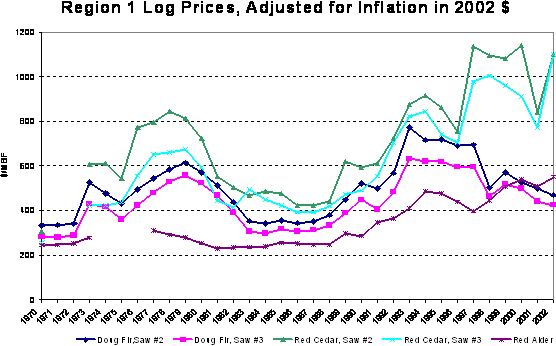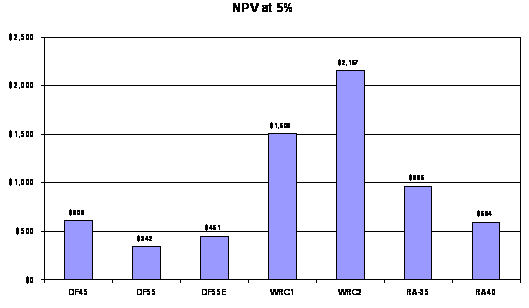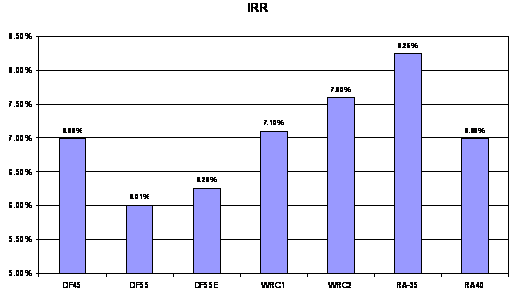 |
 |
 |
 |


FACT SHEET #22
After decades of Douglas-fir plantations, is it time for forest landowners
to consider planting alder and cedar?
|
2003 By Larry Mason
The Pacific Northwest (PNW) has always been famous for its Douglas-fir timber. But gone now are Douglas-fir large log harvests. During the 1990’s, political decisions to stop harvesting from federal lands coincided with completion of original growth harvests on private lands. Abrupt regional timber manufacturing infrastructure adjustments followed. From 1989 to 2003, 378 mills shut down (Ehinger & Associates, 2003). High quality Douglas-fir lumber markets, long dominated by the PNW, shifted to other regions or were served by product alternatives. By 1998, lumber exports dropped to 25% of 1989 levels. Surviving sawmills retooled for lumber production from small diameter logs available from private land commercial thinnings. Large log price premiums disappeared (see Fact Sheet #7). Today, in much of the region, fir saw logs over 24” on the big end are now discounted $100 - $150/mbf. In response, landowners have shortened Douglas-fir rotations to maximize net present value. Traditionally, economists have watched the lumber market as an indicator of national economic health. In bad economic times consumers stop buying houses and a “pent up” demand results that is triggered with the onset of recovery. As home sales increase so do housing starts and the resulting increase in demand for building materials pushes up lumber prices. Historically, increases in log prices have been soon to follow. But today, even with low interest rates and high housing starts, Douglas-fir log and lumber prices are low. This paradigm shift may be particularly threatening to the PNW lumber producers, as this region has high production costs that limit competitiveness when compared against other regions. Red alder and western red cedar have long been recognized by tree farmers as good species to plant in areas that are wet, nutrient poor, infected by Swiss needle cast or root rot or in other ways unsuitable for Douglas-fir. A strong performance by both alder and cedar log prices when compared to Douglas-fir prices may lead some foresters to consider planting alder and cedar on their best sites as well. The following graph displays prices, adjusted for inflation to 2002 dollars, for comparable grades of Douglas-fir, alder, and cedar logs from 1970 to present in the Puget Sound region of western Washington.
Alder prices surpassed Douglas-fir for the first time in history in 2000 and continue to increase. Cedar logs are currently worth more than twice the value of Douglas-fir logs. Interestingly, while Douglas-fir production is largely dedicated to commodity lumber products that compete with other alternatives, both alder and cedar are niche species producing products unique to the PNW.
The above display of Net Present Value (NPV) calculations by species shows that western red cedar out performs both Douglas-fir and red alder with alder performing better than fir. Many landowners express reluctance to plant western red cedar because of difficulties associated with browse damage. The above simulations include additional cost at time of planting cedar of $320/acre for browse control (tubing). Cedar’s remarkable financial performance at present prices would indicate that tree farmers could make even larger investments in browse control strategies and still enjoy returns greater than those of Douglas-fir or alder. An examination of Douglas-fir simulation outputs shows that, even with increases in growth and the benefits of export price premiums on 20% of the harvest, the 55-year rotation (DF55E) cannot compete favorably with the shorter 45-year rotation alternative (DF45).
Internal Rate of Return (IRR) for the same simulations reflects the benefit to forest landowners from shorter rotations. In this case, alder on a 35-year rotation is clearly the winner. It is interesting to note that if it takes just 5 more years to complete the alder rotation (RA40) both of the cedar simulations offer better returns on investment. Even the 40-year alder rotation, however, is very competitive with Douglas-fir.
Management ImplicationsDouglas-fir may be poorly positioned to compete in the small log production of commodity lumber against less costly product alternatives and imports. Subsequently, prices for small diameter Douglas-fir logs may remain low. The closure of large log mills over the last decade has meant that larger Douglas-fir logs are worth even less than small logs. The unique properties associated with higher quality Douglas-fir trees have experienced declining demand. Prices for larger Douglas-fir logs are likely to remain low. Red alder and western red cedar logs provide raw material for niche manufacturers that produce products unique to the PNW. Niche markets more readily absorb high regional production costs and appear to be less price sensitive to competition from product alternatives. Alder and cedar are commonly planted in areas unsuitable for fir regeneration. Rising prices and potentially short rotations may make red alder and western red cedar very attractive species for forest regeneration investments on sites traditionally planted to Douglas-fir. However, unfavorable conditions will limit red alder and western red cedar growth success on dry, hot, or frost-prone planting sites. Western red cedar may be targeted for browse by deer and elk until stems reach a height of 4-6 feet. For the simulations conducted above, $320/acre was calculated as an additional cost outlay at time of planting to allow for tubing of cedar seedlings for browse protection. Financial returns from cedar appear sufficient to cover investments in browse protection. However, given the historic lack of interest in alternative species planting and recent increases in regulatory constraints on harvest activities in riparian zones, there may be some question about whether naturally-regenerated raw material supplies of alder and cedar will be sufficient to support existing manufacturing infrastructure until plantation crops become available. Estimations of available future volumes of alder and cedar saw logs could be helpful to better inform future market potentials. The high value of alder and red cedar would appear to be sufficient to warrant investment in growth and yield research for these species to help inform planting decisions. Species diversity brings value to investment portfolios as well
as to forest environments. Planting of multiple species can reduce
risk from disease or market fluctuations while improving cash flow
from staggered harvest revenues. References: Pease, Dave. 2003. Paul Ehinger: Reluctant "Elder Statesman",
Engineered Wood Journal, Vol. 6, No. 1. pp. 16-19. |






